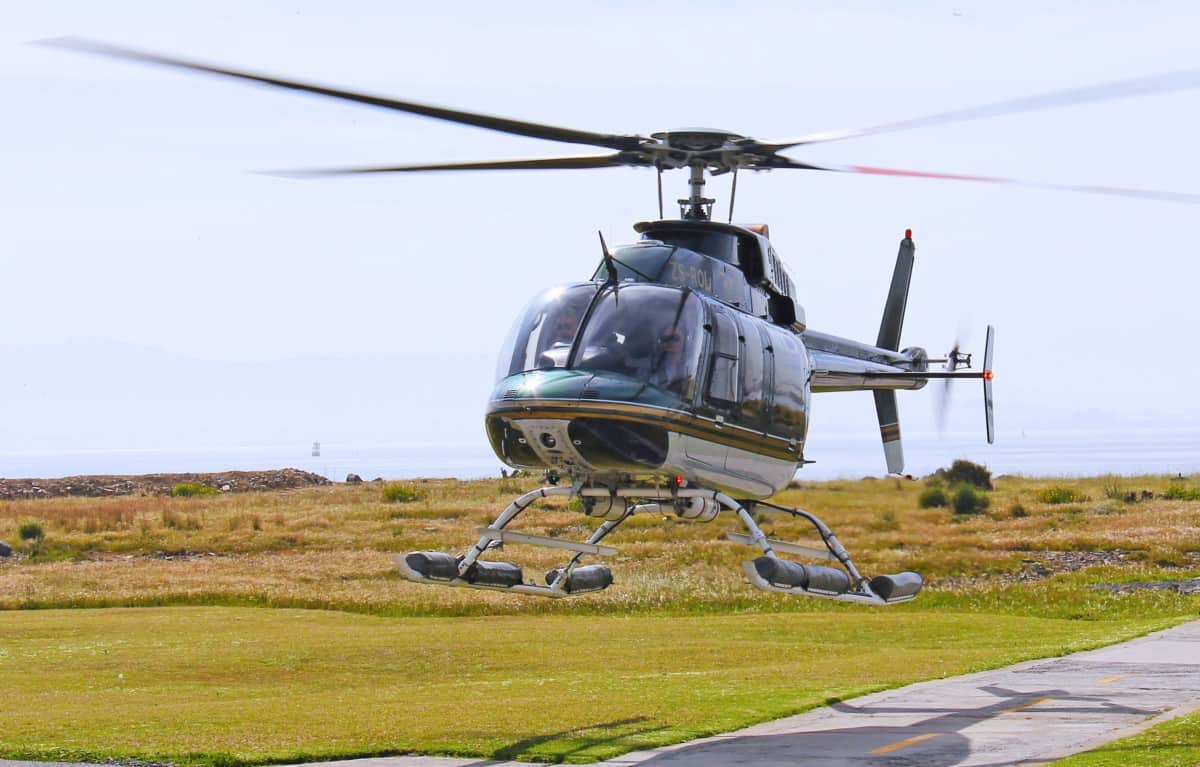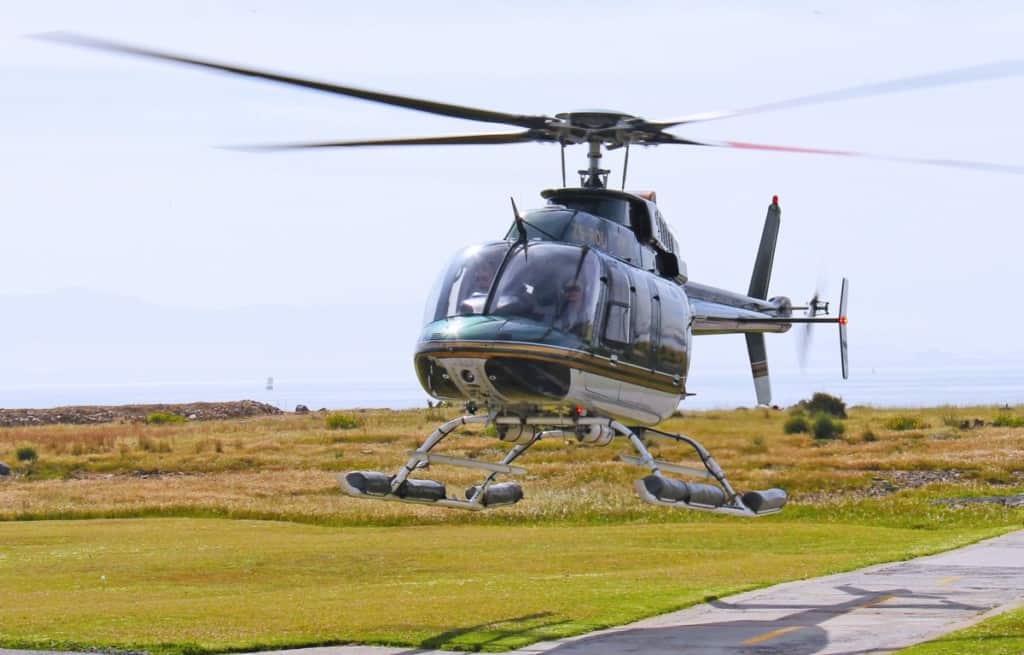
A helicopter sitting in a stable hover is one of the world’s modern technological wonders and when I was learning to master it many, many years ago I can tell you that it made me sweat! Not only is it difficult to learn but the design and technology behind this marvel are truly staggering!
A helicopter hovers by creating lift using its main rotor blades and deflecting air downwards to raise it off the ground. When the amount of lift being produced equals the weight of the helicopter it will stay in a hover. It usually takes around 10 hours for a student to begin mastering the hover.
In this article, I not only want to tell you about the physics and aerodynamics of how a helicopter is able to hover but also what a pilot needs to do to get the aircraft into a hover and keep it there! If that sounds interesting then let’s go and get strapped in!
These will be simple explanations and a lot of the heavy technical aerodynamics are not covered. This website follows the mantra: Everything Aviation – Simply Explained.
Article Contents:
How Does A Helicopter Produce Lift To Be Able To Hover?
Before we go jumping into how it gets off the ground we need to dive into some very basic aerodynamics that allows the helicopter to do its hovering party trick! To get an aircraft (Forget about Rockets) off the ground, an airfoil is used to generate Lift.
The turning rotor blades of a helicopter are its wings. By moving them through the air the shape of each rotor blade creates a lower air pressure above it than below it. This sucks the blade upwards. The pilot then adjusts the pitch angle of the rotor blades to deflect air downwards for control.
In an airplane or ‘Fixed-Wing’, the airflow over its airfoils is created by the entire aircraft moving at speed. That speed is created either by jet engine(s) or propeller(s) creating Thrust. The airfoils on an airplane that create its Lift are its wings.
In a helicopter or ‘Rotary-Wing’, the airflow over its airfoils is created by rotating each airfoil through the air. The rotation of its airfoils is created by either a gas-turbine(s) or piston engine driving a main gearbox which then turns both the main rotor and tail rotor together. The airfoils on a helicopter that create its Lift are its Main Rotor Blades.
The Four Forces of Flight
Now that we have a basic understanding of what components create the Lift we also need to look at three other forces that act on any aircraft when in flight:
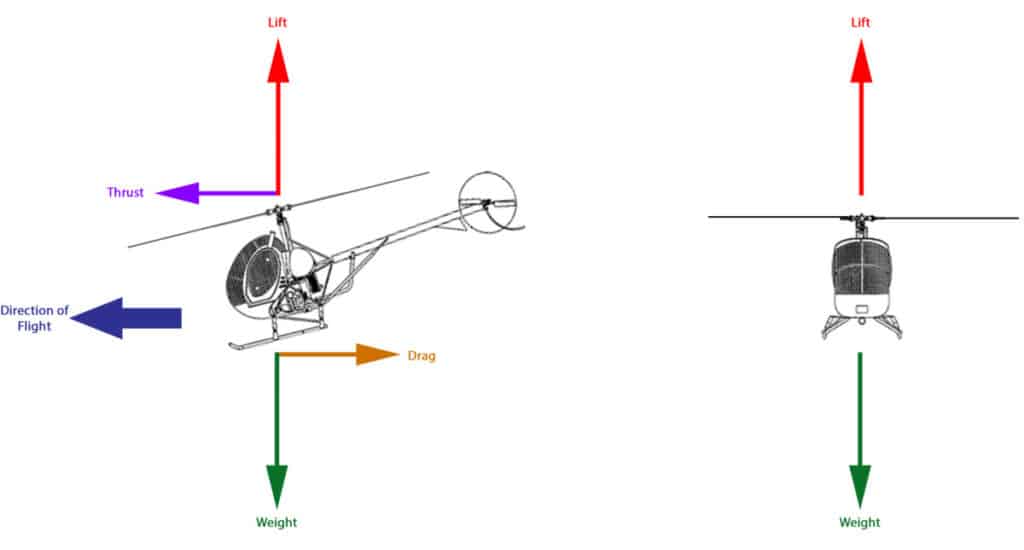
Lift
This is the force an aircraft must generate to overcome Weight. To get an aircraft into the air the Lift created must be greater than Weight.
Weight
This is the total weight of the aircraft and is the opposing force to Lift. This includes the aircraft itself, all of its occupants, all of its cargo, baggage, and fuel. If Weight is more than the Lift the helicopter can produce, then the helicopter will never leave the ground.
Thrust
This is the force acting in a horizontal direction to move the helicopter across the ground. Because a helicopter can maneuver to any spot over the ground the force moving that helicopter horizontally is Thrust.
Drag
Drag is the opposing force to Thrust. The faster a helicopter moves through the air, the more drag it creates. Thrust must overcome Drag to move the helicopter to a new position and the faster it’s going the more Thrust is required.
When a helicopter is in a stationary hover all four forces are balanced
Lift = Weight & Thrust = Drag
How Does A Helicopter Get Off The Ground?
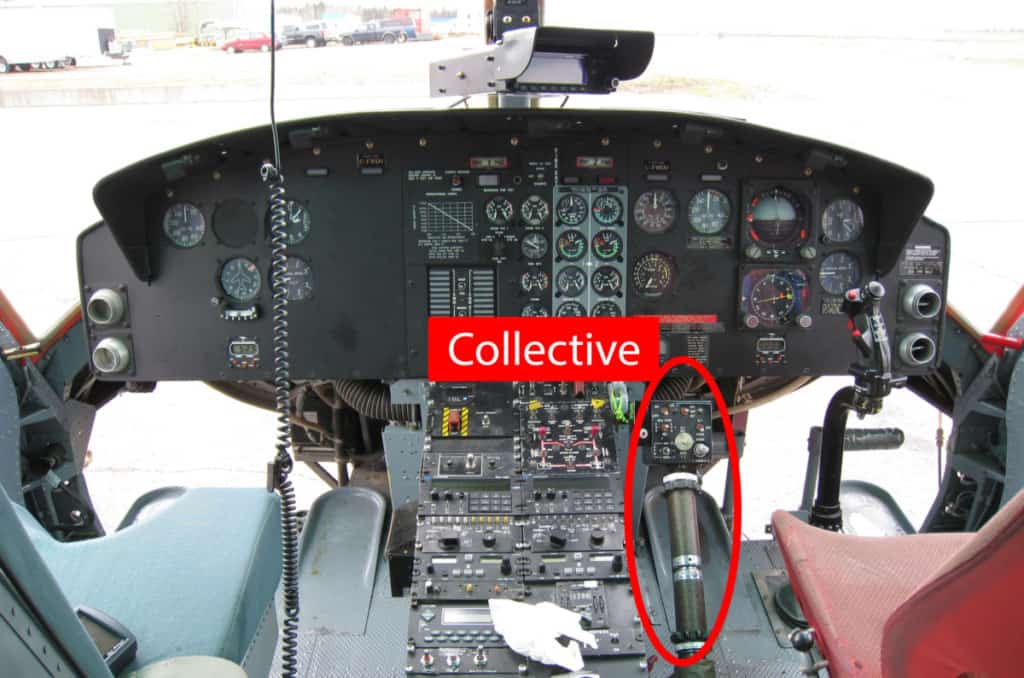
To get the helicopter into a stable hover it first needs to generate enough Lift to overcome its weight. To move the helicopter vertically upwards it needs slightly more Lift than Weight. This will bring the helicopter slowly into the air with a slow upwards movement. When Lift = Weight it hovers.
If the pilot commands the helicopter to create huge amounts of Lift the helicopter will scream into the air like a Bottle Rocket! This is never a good idea!
To create this slightly more increase in Lift, the pilot uses the Collective Control which they operate with their left hand. When the pilot raises the Collective it moves mechanical and/or hydraulic linkages that move a device called a ‘Swashplate’ up the Main Rotor Drive Shaft.
The Swashplate is an ingenious device that allows the aircraft control linkages to transmit their movements into the rotating parts of the Main Rotor System and its rotor blades.


When the Swashplate moves upwards, it increases the Pitch Angle on every Main Rotor Blade at the same time – Think of sticking your hand out of the car window as a kid. When your hand was flat it stayed parallel to the ground. When you rotated your hand upwards it would catch the wind and fly upwards. This is the Pitch Angle of your hand.
As the Pitch Angle of each Main Rotor Blade is increased it creates more Lift and each blade wants to go upwards. Because the helicopter is connected to all its Main Rotor Blades, the helicopter follows.
The helicopter will continue to climb until one of three things happen:
- The air becomes less dense and therefore are fewer air molecules for the airfoils to create Lift with, or:
- The pilot slightly lowers the Collective and Lift and Weight become equal – This is the point at which a helicopter hovers, or:
- The pilot increasingly lowers the Collective and Lift become less than Weight – This will cause the helicopter to descend.
Note:
As the Pitch Angle on a helicopter airfoil/rotor blade increases, the Drag it creates also increases. This drag will try to slow down the rotational speed of the rotor blade and to maintain the helicopter rotor system at the desired RPM, the engine/s also increases power to overcome the drag.
When the Collective is raised, it raises the Swashplate to increase the blades’ Pitch Angle and it increases engine power through a linkage or digital engine control input.
Learn More…
Try These Articles:
* Becoming a Helicopter Pilot: The Complete Cost Breakdown
* Best Helicopter To Train In? – An Instructor Weighs in
How Does A Helicopter Stay In Position Over The Ground?
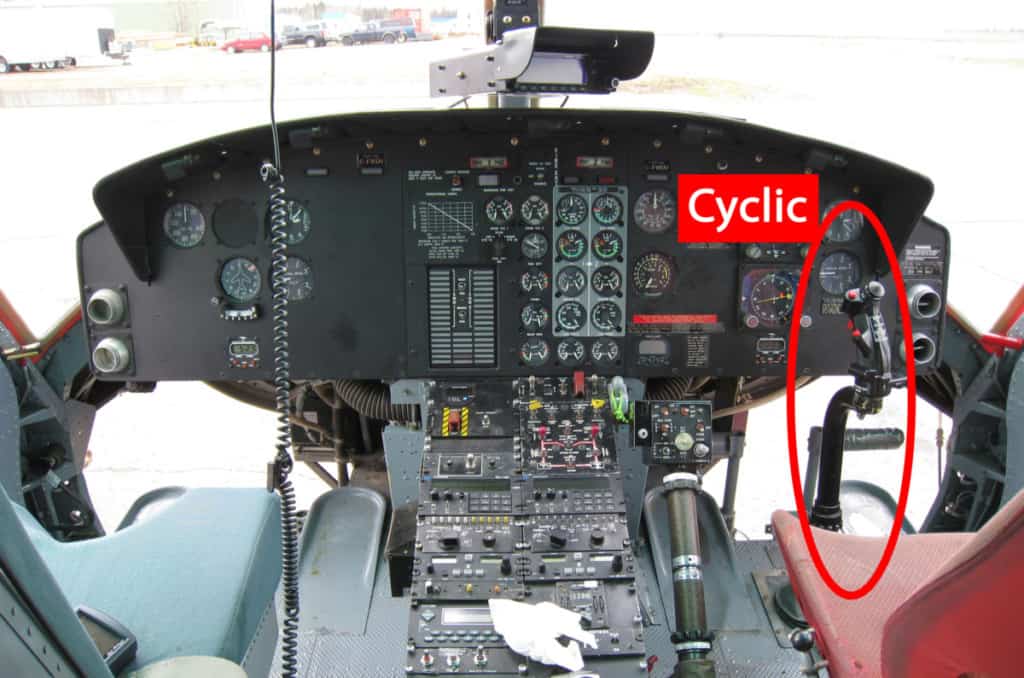
Now that the helicopter is in the air and is neither climbing nor descending, its position over the ground needs to be controlled.
To maintain its position over the ground the pilot uses a control called the Cyclic with their right hand. This connects to the swashplate via mechanical and/or hydraulic linkages. The Cyclic tilts the swashplate in the direction the pilot wishes to go and the rotor system follows and moves the helicopter.
This effectively tilts the Main Rotor Disk (When the blades are turning they look like a solid disk) in the direction the pilot wishes to go and the helicopter then follows.
This tilts the Vertical Lift vector in the direction the pilot wants to go and this creates a sideways Thrust vector. As the Thrust vector increases, it overcomes the Drag and the helicopter begins to drift in the required direction.
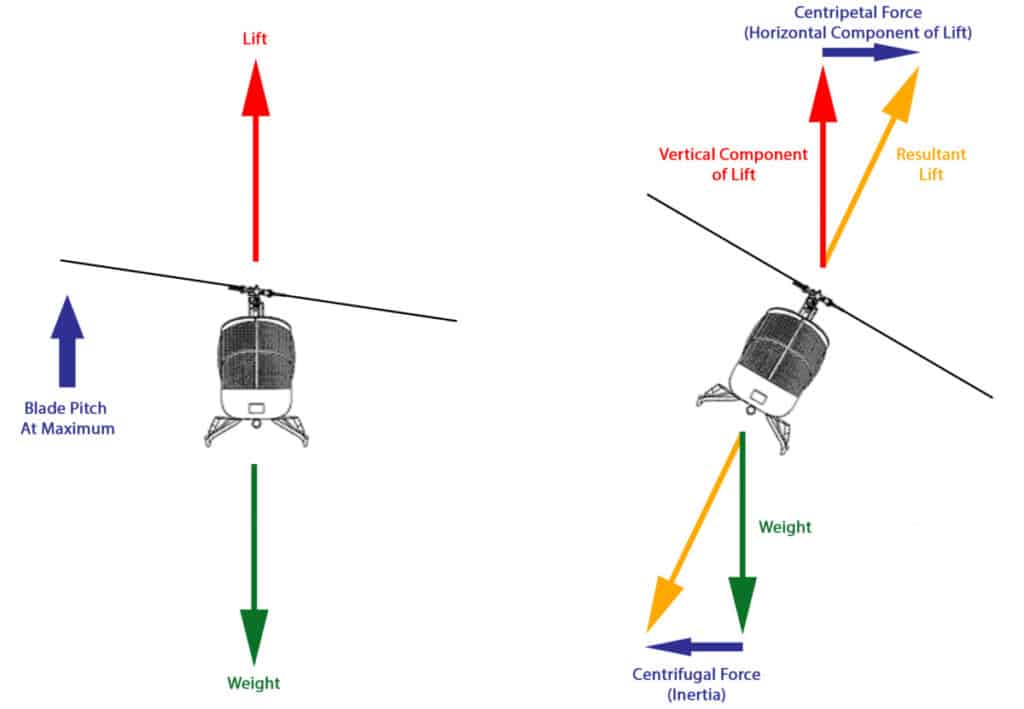
Just like lifting into a hover, the helicopter will continue to move until the pilot stops it. To stop the horizontal motion the pilot needs to move the Cyclic in the opposite direction to slow and stop and movement, then the pilot needs to center the Cyclic to equalize the Thrust/Drag and maintain the helicopter’s position over the new desired spot.
A good pilot will be able to move the helicopter without the passengers ever seeing the Cyclic move. The inputs made on the Cyclic are very sensitive and it is more of a pressure that the pilot puts on the control with their hand. Large Cyclic movements make the helicopter dance which will certainly be noticed by passengers or create a swing in the external load that is slung underneath the helicopter.

Join My Newsletter & Get Great Tips, Information and Experiences To Help You Become a Superb Pilot!
How Does A Helicopter Stay Pointing In The Right Direction?
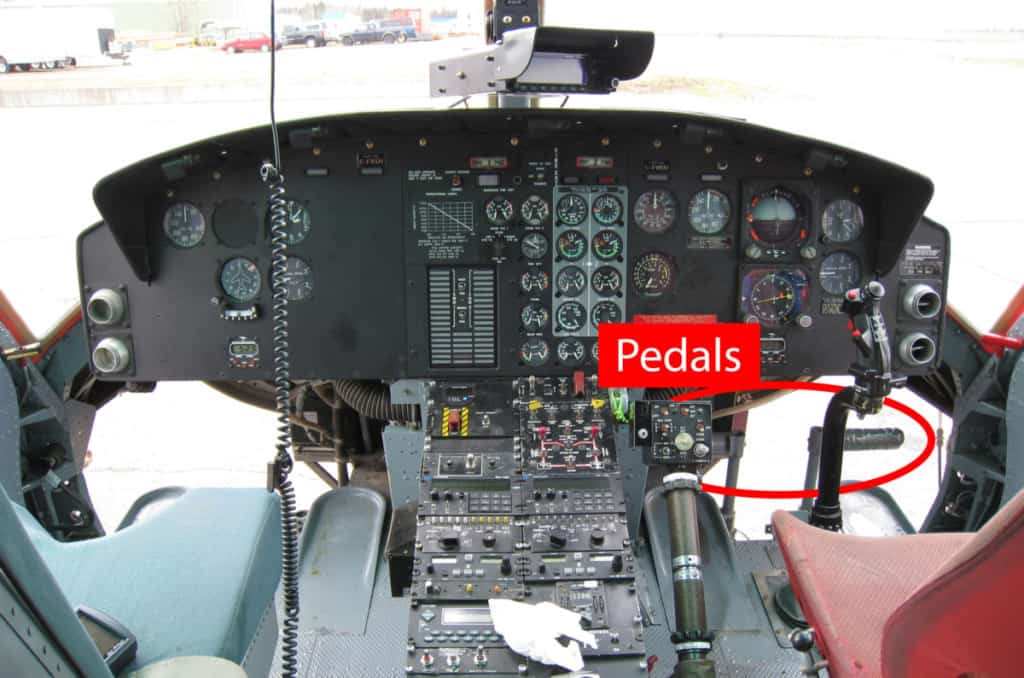
The pedals control the Tail Rotor at the rear of most conventional helicopters. The pedals control how much Thrust the Tail Rotor System produces. By producing more thrust the helicopter rotates (Yaws) in one direction. Producing less thrust allows the torque to pull the nose in the opposite direction.
As the Main Rotor System rotates in one direction, the fuselage of the helicopter wants to rotate in the opposite direction due to Newton’s Third Law of Motion:-
‘For Every Action, There is an Equal and Opposite Reaction’
Without a Tail Rotor counteracting the Torque, the second the helicopter left the ground it would spin in the opposite direction to the Main Rotor. When the helicopter is designed the engineers balance the Pitch Angle of the Tail Rotor Blades to produce enough Thrust to equal the Torque, thus when the helicopter lifts off the ground it remains pointing in the same direction.
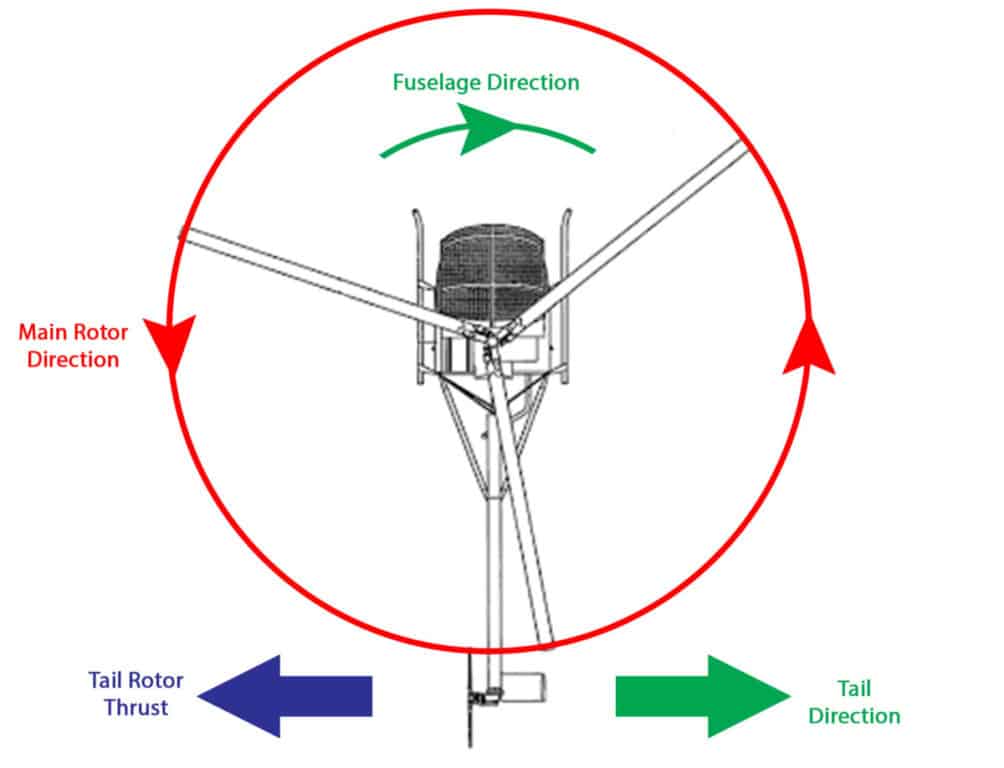
When the pilot is sitting in a helicopter, which has a main rotor that turns Anti-Clockwise and wishes to turn the helicopter to the left, they push on the left pedal and this increases the Pitch Angle on the Tail Rotor Blades which creates more Thrust (Thrust is similar to Lift but in a horizontal direction). When Thrust is greater than the Torque, the helicopter will slowly begin to turn to the left using the Main Rotor Mast as the pivot point.
When the pilot wishes to turn the helicopter to the right, they push on the right pedal and this decreases the Pitch Angle on the Tail Rotor Blades which creates less Thrust. When Thrust is lower than the Torque, the helicopter will slowly begin to turn to the right.
Just like the Collective and the Cyclic, to stop the movement the pilot will need to apply the opposite pedal to slow and stop the rotation, then center the pedals to neutral to maintain the helicopter pointing in the desired direction.
Balancing All The Helicopter Controls
So now that each control is mastered here comes the punch you never saw coming…
When you move just one control it affects all the others! And you need to adjust every other control by the right amount and at the right time to keep the helicopter in balance and this is the part that can take a student pilot dozens and dozens of hours to get acceptable and it can take hundreds of hours if not thousands to truly master!
The easiest way to describe how to hover a helicopter is to talk you through picking up into the hover and then we will move into forward flight:
- Your eyes need to be out on the horizon or at least a good distance away from the helicopter. This will allow you to notice small movements.
- Slowly start raising the Collective until the helicopter begins to get light on its skids or wheels.
- Adjust the pedals to keep the nose pointing straight ahead.
- Adjust the Cyclic to prevent any drift or rolling motion of the helicopter. The Thrust from the Tail Rotor will try to push the helicopter to the left.
- Slightly increase the Collective to bring the helicopter off the ground and maintain heading with Pedals and Drift with Cyclic.
- Allow the helicopter to rise to approximately 5ft above the ground.
- Slightly reduce the Collective to stop the climb and maintain heading and drift.
Simple right!! For any of you that have tried to do this, you will know how hard it is! Teaching a student to hover is my favorite part of all the training!
So to move into forward flight…
- Apply slight forward pressure on the Cyclic and hold it there.
- There is a slight delay then the helicopter will begin to start moving forward. (This delay is the hard part to master!!!)
- Because some of that Vertical Lift is now being used to create Forward Thrust to move the helicopter forward, the Lift will be less than the helicopter’s weight, thus the helicopter will begin to descend.
- Slightly raise the Collective to maintain height.
- Because the Collective has been raised, more power has been demanded by the engine, it creates more Torque on the fuselage, therefore the pilot needs more left pedal to maintain heading. This also increases the Thrust produced by the Tail Rotor which will push the helicopter left.
- Maintain heading with the pedals and prevent drift with opposite Cyclic pressure.
- As the aircraft begins to accelerate to around 15-20kts the Main Rotor System goes through a process known as ‘Translational Lift’, in a nutshell, this improves the performance of the Main Rotor System and if the pilot does nothing, this performance increase will allow the aircraft to begin climbing.
- The climb portion should not start until the helicopter is around 40kts in most helicopters, so to stop this climb, the pilot must slightly lower the Collective to maintain height over the ground – 5ft.
- Now the Collective is lowered, less power is required, less Torque is being produced so less left pedal is required and less right Cyclic is required to prevent the drift created by the Tail Rotor Thrust.
- As the helicopter reaches 40kts the pilot can begin to raise the Collective to Climb Power and continue to apply forward pressure on the Cyclic to gain airspeed until they reach their optimum climb speed for their particular helicopter.
- More power required means more torque on the fuselage, thus more left pedal is required to maintain heading.
- More forward speed moves more of the vertical Lift vector away from vertical therefore even more power is required to maintain the climb, which also means more left pedal and more right Cyclic to maintain the flight path with no drift.
And just like that you have lifted into a hover and flown away! Easy right?! For my student’s sake, I wish it was!
Factors That Work Against Holding A Stable Hover
Mastering the hover is not just about manipulating each control at the right time and in the right amount, that would be too easy! To help make hovering even more of a challenge there are several other factors that get thrown into the mix:
Wind
Mother Nature can really be a cruel lady, at least that is what it can feel like when you are first learning to hover. When the wind is blowing or worse, gusting, your attempts at keeping the machine stable are an endless battle. The wind will push the helicopter, make it climb, make it descend, or try to weathercock you to face in another direction. All while trying to get the hang of those controls.
This was how I learned to hover! When I first learned to fly in the UK it was ALWAYS windy, that’s what it seemed like anyways! But once you master hovering in wind and learning to smoothly maneuver the helicopter in wind then flying in calm conditions is simple! No matter what, the wind is going to play a factor at some points during a student’s training and it will make them sweat and curse and laugh. I think this is why it feels like such an accomplishment once they get the hang of hovering.
Pendulum Effect
A pendulum is a weighted object that swings from side to side from a pivot point above it. The pendulum effect is what can make the helicopter seem to get out of control very quickly because a helicopter hangs under its main rotor system and this makes the helicopter act like a pendulum. This is even more pronounced in helicopters with only two Main Rotor Blades, hinged in the middle like a Teeter-Totter.
When a student pilot is trying to hover the helicopter will be swinging around like the pendulum. When the helicopter swings one way, the student will place in an opposing control movement and the helicopter will then swing back, but a little further usually because the student put in too much of a control input to correct the swing.
This then repeats side to side or back and forth, with each swing getting slightly larger until there becomes a point when the helicopter is then pointing nose-first at the ground or they are looking at grass off of their shoulder. This is usually the point when the student yells out “You Have Control!!!”. Depending on if I’m wanting to push the student a little I would tell them “No, You got us into this, you get us out of it!”. Once it gets to a point where flight safety starts approaching its limit then the instructor will take control, cancel the swing and bring the helicopter straight into a hover within seconds, usually at the annoyance of the student!
The pendulum effect is mainly exacerbated by the next factor – Overcontrolling.
Overcontrolling
Overcontrolling is the by far the biggest factor when first learning to hover. Knowing how much to move a control by the right amount is only something that cant be learned by doing. By the time an instructor has told the student how much to move a control, the time for the input has passed. As I mentioned earlier, it is more about putting pressure on the controls rather than movements. The Cyclic really never needs to move more than 1” in any direction to smoothly control a helicopter.
When a helicopter has a delay to the control inputs the student pilot tends to keep pushing more on the cyclic especially, as they are not seeing any reaction to their control input. By the time the input takes effect and the helicopter reacts it is usually too much and hence overcontrol.
As time and skill progress the pilot will reach a point where they begin to put in the control input and then wait. If the desired result is not enough another small control input is required. This is when the student pilot is starting to get the hang of hovering. Some students can get to this point in a couple of hours whereas some can take a little longer. It truly is like learning to ride a bike!
Control Delay
Control Delay in a helicopter is the time it takes for a control input made by the pilot to take effect. It is most noticeable with the Cyclic control. In simple terms, It is caused because the rotor head has to make the Pitch Angle change on the rotor blades, the Lift of each rotor blade then alters, and tilts the entire rotor head, then due to the Pendulum Effect, the fuselage then follows. This can take anywhere from almost instantaneous to a second or two depending on the helicopter type, but when a student pilot is wrestling with the helicopter, this delay is what will cause the Overcontrolling.
The key to controlling a helicopter in a hover is to make the control input and wait. See if the helicopter moved the desired amount then try the input again and wait.
Some helicopters are more responsive than others but the most common helicopters used for training usually have the biggest control delays. The two-bladed ‘Teetering’ main rotor heads are the worst for control delay due to their Zero Hinge Offset design. But they are cheaper to manufacture, have fewer parts and maintenance is simpler leading to a lower run-cost. This makes them perfect as training machines from a financial standpoint but gives the student a bigger workout.
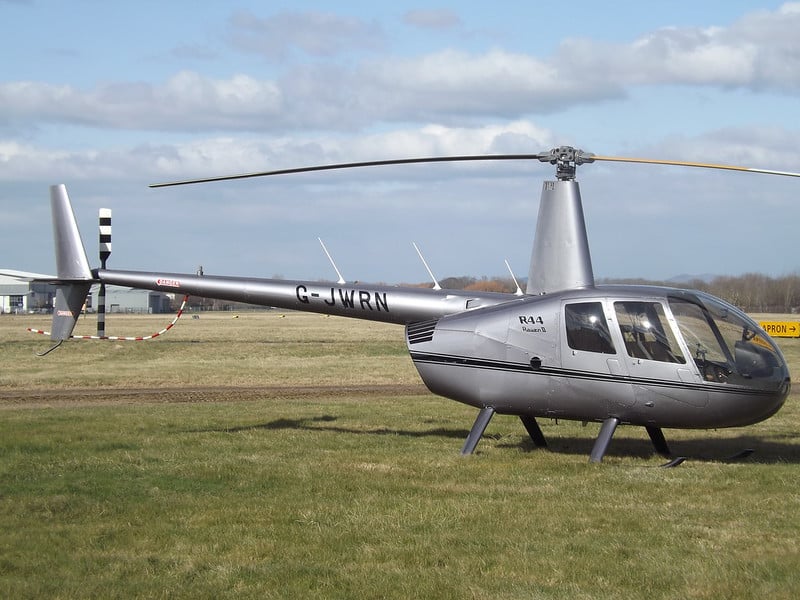
To be honest, once you have learned the hard way on how to hover a helicopter, any helicopter afterward will be a lot simpler. I trained on the Robinson R22 and hovering in the Agusta AW139, Sikorsky S76 or Airbus AS350 are a piece of cake compared to the Robinson. But I can instantly tell when I fly with a pilot who learned to hover in a 2-bladed helicopter in wind as they are much more stable than pilots who trained in helicopters like the Schweizer or Cabri helicopters that have 3-Bladed Main Rotor Systems.
Learn More…
Try These Articles:
* Helicopter Engine Failures – A Pilot Properly Explains!
* Learning To Fly Helicopters – Is it really that hard?
Can Helicopters Stop In Mid Air?
A helicopter can transition from forward flight and come to a complete stop at any altitude within its flight envelope. The pilot uses the cyclic to place the aircraft into a decelerating nose-up attitude while raising the collective to increase power to maintain altitude until the helicopter is in a hover.
As the helicopter slows down, more power is applied, and providing there is enough power to support the weight of the helicopter for the given atmospheric conditions the helicopter will come to a hover. The height of this hover is limited purely by the amount of power the engine/s can produce or the amount of lift that can be created by the main rotor system.
How High Can a Helicopter Hover?
The highest ever hover in a helicopter was completed by Didier Delsalle as he landed on top of Mount Everest at 29,029ft/8,848m on May 14, 2005 in a Eurocopter AS350 B3 Astar. Once a helicopter engine/s reach their maximum power output the helicopter can hover no higher.
There are several factors that affect how high a helicopter can hover before it runs out of power from its engine/s:
- Altitude
- Temperature
- Humidity
- Weight
- Wind
Altitude
The higher the helicopter goes, the fewer air molecules there are for the rotor blades to work on and the engine to mix with fuel, burn and produce power. There reaches a point where the number of air molecules in a given area is not enough to keep the helicopter airborne or produce enough power.
Temperature
The warmer the temperature, the more the air molecules vibrate causing fewer molecules to occupy a given space. The hotter the ambient air temperature, the fewer molecules there are for the blades and engine to work on.
Humidity
The more moisture there is in the atmosphere, the more water goes into the engine. Water takes up the space that would be used by air thus the engine/s produce less power.
Weight
The heavier the helicopter is, the more power the engine/s have to produce and the more lift the main rotor has to create to overcome the weight of the aircraft. The lighter a helicopter is, the higher it can go before the engine/s or the main rotor reaches its capable limit.
Wind
Wind allows an increase in performance due to an aerodynamic efficiency of the main rotor system as it blows across the blades. This increase in performance reduces the power demand from the engine/s so a helicopter can hover higher using this extra power available from the engine.
Maximum Hover Height
As each helicopter model is different, its manufacturer publishes hover height charts for its helicopter based on the factors listed above. There are usually at least two charts available:
- HIGE – Hover In Ground Effect
- HOGE – Hover Out of Ground Effect
Hover In Ground Effect is when the helicopter hovers close to the ground (Usually within 1.5x its rotor diameter = 30ft rotor diameter = HIGE within roughly 45 ft off the ground).
Hover Out of Ground Effect is any height higher than HIGE. It requires far more power for a helicopter to hover out of the ground effect as the rotor system again, has an aerodynamic increase in performance when hovering close to the ground but when away from the ground, this performance increase disappears.
For Example:
Same Helicopter weighing 4,700 lbs with 10°C air temperature:
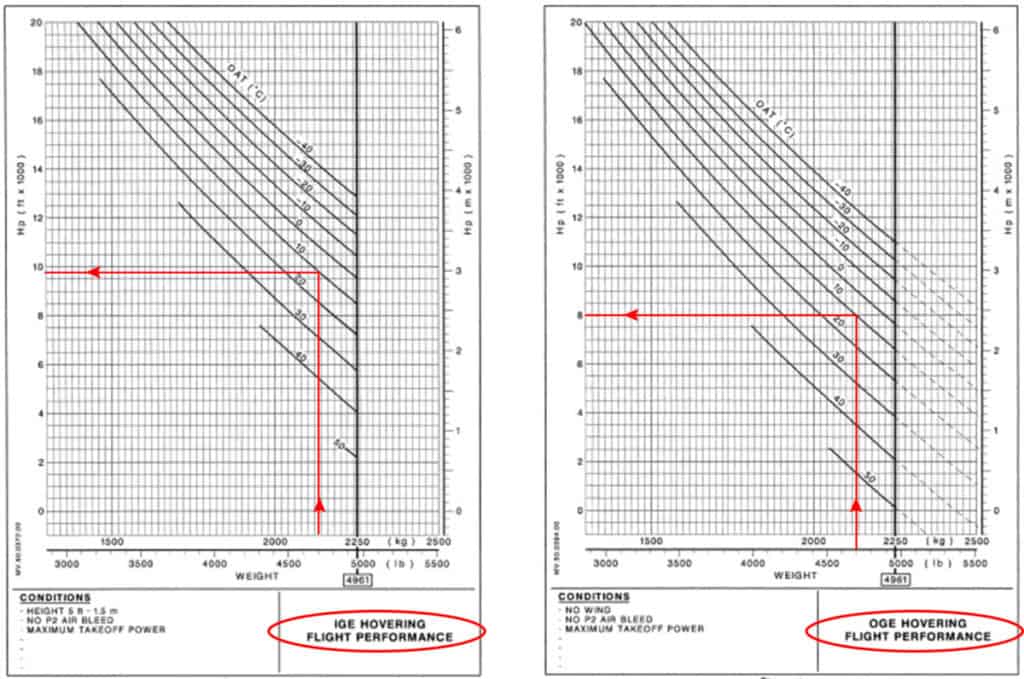
The chart on the left shows In Ground Effect = Helicopters max altitude it can hover over the ground is 9,750 ft – eg helipad on a mountain.
The chart on the right shows Out of Ground Effect = Helicopter’s Max Altitude it can hover in mid-air is 8,000 ft – eg doing a 100ft winch rescue off a mountainside.
As you can see, by being closer to the ground the helicopter is able to hover at a higher altitude because of the performance increase created by the rotor system when near to the ground. Pilots reference these charts when wanting to conduct operations when the temperatures warm up, when required to work at high altitude, or when lifting heavy loads.
By inputting the temperature and altitude it will tell the pilot the maximum weight the helicopter can be for that operation:
For Example:
A helicopter needs to complete a winch rescue at 10,000ft and the computed temperature there is +10°C.
By using the HOGE chart, because it’s a winch operation, the pilot starts on the left axis at 10,000ft and goes across to the +10°C curve. Where the two lines intersect, they draw a line straight down to see the maximum weight the helicopter can be when it reaches that altitude = around 4,300 lbs.
If the helicopter is over this weight it will not be able to maintain a hover once on the scene as it will not have enough power to overcome the weight of the helicopter.
Learn More…
Try These Articles:
* Can Helicopters Fly In Zero Visibility? It Depends!
* Computer Flight Simulators: Can You Really Learn To Fly On Them?
How Long Can a Helicopter Hover?
Most helicopters have a fuel capacity that allows it to hover for around 2 to 3 hours. When a helicopter is in a hover it is using its most amount of power which causes the most amount of fuel consumption, therefore most helicopters fly orbits over a subject rather than stay in a hover to fly longer.
In the Astar AS350 B2 that I fly, it has a fuel consumption of 180 liters per hour. It has a 540 liter fuel tank so technically it could hover for 3 hours. This would, however, run the fuel tank dry and the engine would stop while in flight therefore most helicopter companies are mandated to maintain a 20 minute fuel reserve to prevent this.
Therefore I would be able to hover for 2h40 minutes before I needed to refuel.
To Finish
Hovering a helicopter is incredibly hard when any person first tries it. No matter how much they claim. I have seen students with the biggest ego’s instantly put in their place once we go out and try hovering. Even those with good balance and hand-to-eye coordination.
If you have never taken the controls of a helicopter in your hands before I highly recommend you go and book yourself a trial lesson at your local school and have a go. it will be one of the most challenging and fun memories you will keep for the rest of your life! Oh, and the video your family member will get will also prolong the experience or humiliation!
No matter your interest in aviation, go and give it a try! If nothing else it will give you a great appreciation for how good those pilots are that sit up front and don’t even feel the helicopter lifting off, flying, and setting down. They make it look easy, but it takes years of practice on a machine to become one with it. The pros always make it look easy – Until you try it yourself!

